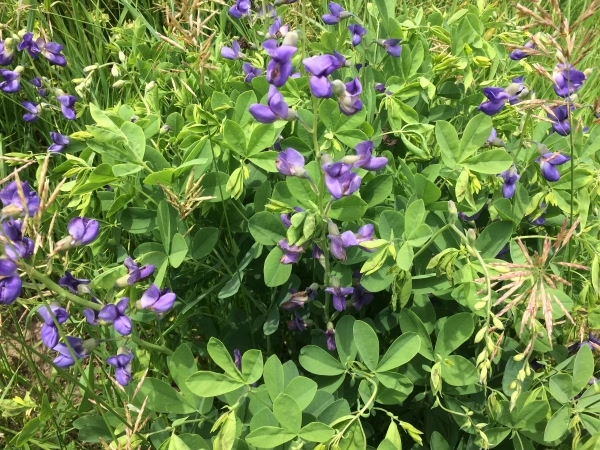
Blue False Indigo
Botanical Name
:
Baptisia australis
Plant Type
:
Herbaceous perennial
Seasons
:
Plant in spring; blooms in late spring/early summer
Sun Level
:
Full sun to part shade (prefers full sun of at least 6 hours per day)
Ideal Soil Temperature for Planting
:
50–70°F (10–21°C)
Soil Type
:
Well-drained, average to poor soil (tolerates clay, loam, and sandy soils)
Hardiness Zones
:
3–9 (USDA)
Germination
:
Can be propagated from seed, but it can be slow and take several years to flower
P.H. Level
:
Slightly acidic to neutral (6.0–7.0)
Water/Irrigation
:
Water during the first year to establish roots, then only as needed during prolonged dry spells. Drought-tolerant once established
Fertilization
:
Usually not necessary. May benefit from a light application of balanced fertilizer in early spring before new growth begins, but avoid over-fertilizing
Habit
:
Upright, bushy, clump-forming
Propagation
:
Seed or division (division can be difficult due to deep taproot)
Final Plant Height
:
3–4 ft
Spread
:
3–4 ft
Flowers
:
Pea-like, indigo blue (can also be violet-blue or purple)
Attracts
:
Butterflies, bees, hummingbirds
Uses
:
Borders, cottage gardens, prairies, meadows, native plant gardens, specimen plant
Companions
:
Plants that prefer similar growing conditions, such as coneflowers (Echinacea), yarrow (Achillea), and ornamental grasses
Pruning
:
Cut back stems after flowering to maintain shape and prevent self-seeding, or leave seed pods for winter interest
Toxicity
:
Generally considered non-toxic to humans, but may cause mild stomach upset if ingested
Pests
:
Rarely bothered by pests, but can be susceptible to weevils and aphids
Diseases
:
Generally disease-resistant but can be affected by powdery mildew and leaf spot
Fun Fact
:
Baptisia australis was used as a substitute for true indigo dye by early American colonists
Confused With
:
Other Baptisia species, sometimes confused with wild indigo (Baptisia tinctoria) or other blue-flowered legumes. Also, sometimes confused with Lupinus (lupine) when not in bloom
Additional Info
:
It is a long-lived perennial. Deep taproot makes it difficult to transplant once established. Seed pods are ornamental and can be used in dried arrangements
Botanical Name
:
Baptisia australis
Plant Type
:
Herbaceous perennial
Seasons
:
Plant in spring; blooms in late spring/early summer
Sun Level
:
Full sun to part shade (prefers full sun of at least 6 hours per day)
Ideal Soil Temperature for Planting
:
50–70°F (10–21°C)
Soil Type
:
Well-drained, average to poor soil (tolerates clay, loam, and sandy soils)
Hardiness Zones
:
3–9 (USDA)
Germination
:
Can be propagated from seed, but it can be slow and take several years to flower
P.H. Level
:
Slightly acidic to neutral (6.0–7.0)
Water/Irrigation
:
Water during the first year to establish roots, then only as needed during prolonged dry spells. Drought-tolerant once established
Fertilization
:
Usually not necessary. May benefit from a light application of balanced fertilizer in early spring before new growth begins, but avoid over-fertilizing
Habit
:
Upright, bushy, clump-forming
Propagation
:
Seed or division (division can be difficult due to deep taproot)
Final Plant Height
:
3–4 ft
Spread
:
3–4 ft
Flowers
:
Pea-like, indigo blue (can also be violet-blue or purple)
Attracts
:
Butterflies, bees, hummingbirds
Uses
:
Borders, cottage gardens, prairies, meadows, native plant gardens, specimen plant
Companions
:
Plants that prefer similar growing conditions, such as coneflowers (Echinacea), yarrow (Achillea), and ornamental grasses
Pruning
:
Cut back stems after flowering to maintain shape and prevent self-seeding, or leave seed pods for winter interest
Toxicity
:
Generally considered non-toxic to humans, but may cause mild stomach upset if ingested
Pests
:
Rarely bothered by pests, but can be susceptible to weevils and aphids
Diseases
:
Generally disease-resistant but can be affected by powdery mildew and leaf spot
Fun Fact
:
Baptisia australis was used as a substitute for true indigo dye by early American colonists
Confused With
:
Other Baptisia species, sometimes confused with wild indigo (Baptisia tinctoria) or other blue-flowered legumes. Also, sometimes confused with Lupinus (lupine) when not in bloom
Additional Info
:
It is a long-lived perennial. Deep taproot makes it difficult to transplant once established. Seed pods are ornamental and can be used in dried arrangements
Written by Nondiah Khalayi – https://www.linkedin.com/in/nondiah-khalayi/

